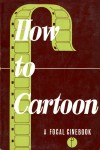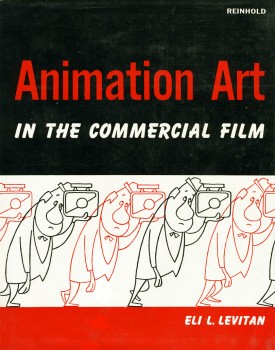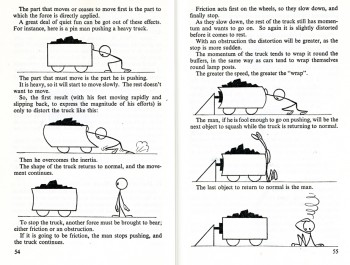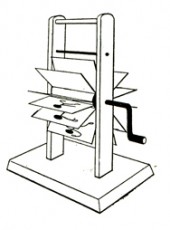Books 17 Apr 2007 07:52 am
How-To Books – part one
- It’s time to talk about books that try to tell you how to make animated cartoons. For better or worse, my interest is in 2D animation of the old fashioned kind. I don’t know enough about cgi animation to know if a book is good, so I won’t talk about them. I don’t like Flash animation, as it exists now, so I’ve never looked at a book about that method of production. I couldn’t tell you what I think is a good book, since I don’t know of any. (Yes, I know my bias is somewhat elitist, but that’s something I’m not going to apologize for. I’m a 2D guy, and can’t change that. I also love puppets and have worked in stop motion, hence I’ll broach that subject, too.) I love the old kind of animation, am glad to be doing it on a computer – using the most modest of methods – so that’s all that I can discuss. What I know.
Saying that. Here’s my first of the How To posts. There are so many books out there, that I couldn’t do it all in one shot. I’m going to start by talking about books that are hard to find.
 - At one time John Halas was the grandaddy of animation writers. He wa enormously prolific with a number of successful books on how to make animated films. His book, How To Cartoon for Amateur Films was the first, done in 1951 with Bob Privett.
- At one time John Halas was the grandaddy of animation writers. He wa enormously prolific with a number of successful books on how to make animated films. His book, How To Cartoon for Amateur Films was the first, done in 1951 with Bob Privett.
This book is a pocket sized paperback with lots of simple little pen & ink illustrations showing how to build a camera, how to draw with arcs and all the materials you’ll need. The book, to me, seems excessively detailed and complicated since it’s trying to speak to “amateurs.”
Some of the illustrations are priceless. Here are two:
 – Of course, Halas‘ finest book was The Technique of Film Animation which he wrote with Roger Manvell. This book covers all aspects of animation (done in 1959 when it was first publilshed) from cel to cutout to stop-motion.
– Of course, Halas‘ finest book was The Technique of Film Animation which he wrote with Roger Manvell. This book covers all aspects of animation (done in 1959 when it was first publilshed) from cel to cutout to stop-motion.
The illustrations in the book are so engrained in my subconscious that I pull them out as reference often. (Just recently when a friend was looking for animation references on fire, I emailed her as one example, the series of Goofy cels holding the Olympic torch (interestingly the authors mistakenly attribute them to Clock Cleaners) on page 195. Everyone owns this book, don’t they? If not stop wasting time and get a copy somewhere. Try a discount used-book shop like the Strand.
The oddest part of this book is the article in the back of the book by Brian G.D. Salt., Mathematics In Aid of Animation. I’ve always considered myself fairly good at math, but somehow I’ve never been able to understand this chapter. I must have tried reading it a dozen times. I’m sure it’s just me, but I don’t mind admitting it. Somehow, I don’t feel as if I’m missing anything.
 – Eli Levitan, who started in the business as an errand boy at Fleischer’s, wrote a number of books that were all nuts and bolts and never inspired me. Just the same, I still think of them as an important part of my past. His book Animation Art in the Commercial Film is a book I gave some attention to in the past, and I suggest you go to that post to get more information about this book. Check it out here.
– Eli Levitan, who started in the business as an errand boy at Fleischer’s, wrote a number of books that were all nuts and bolts and never inspired me. Just the same, I still think of them as an important part of my past. His book Animation Art in the Commercial Film is a book I gave some attention to in the past, and I suggest you go to that post to get more information about this book. Check it out here.
It’s interesting that Levitan also wrote one of the first consumer books about computer animation in 1977. This book has a big title: Electronic Imaging Techniques: A Handbook of Conventional and Computer-Controlled Animation, Optical, and Editing Processes.
- Finally let me point to a book that I’m not really going to recommend since its information  is so basic, but it did interest me for years. E.G. Lutz wrote Animated Cartoons, How They Are Made Their Origin and Development back in 1920. Back in my younger years, this book was referenced more often than any other by the great animators of the Golden Age. Everyone from Chuck Jones to Walt Disney to Walter Lantz to Bob Clampett mentioned it in interviews I’d read. It became a mission of mine to find the book. My local library in New York didn’t have one, so I kept my eyes open. Eventually, I was able to find one from a rare book dealer, but that happened long after I was well settled in the business.
is so basic, but it did interest me for years. E.G. Lutz wrote Animated Cartoons, How They Are Made Their Origin and Development back in 1920. Back in my younger years, this book was referenced more often than any other by the great animators of the Golden Age. Everyone from Chuck Jones to Walt Disney to Walter Lantz to Bob Clampett mentioned it in interviews I’d read. It became a mission of mine to find the book. My local library in New York didn’t have one, so I kept my eyes open. Eventually, I was able to find one from a rare book dealer, but that happened long after I was well settled in the business.
The book does have a lot of basic information and must have been a real revelation in 1920 to so many people. I guess it was the only book that was available at the time, so it’s understandable how many people back in the silent era were influenced.
A company called Applewood Press reprinted it in 1998, so it’s easy to locate in its reprinted version. hell, now you have the internet, so the original version can be found fairly easily.



on 17 Apr 2007 at 8:24 am 1.Mark Mayerson said …
If I remember correctly, Salt wrote an entire book about math for animation. When I worked in Iowa in the late ’70′s, Bob Haack was able to figure it out and programmed an early Radio Shack computer with Salt’s algorhythms and we used it to generate numbers for camera moves. At that point, Bob didn’t own a printer, so we had to copy the numbers off the screen onto our dope sheets by hand.
When I got back to NY in 1980 and was working at Zander’s, I noticed that Al Martino was winging it on writing the numbers for camera moves. He may have been using a calculator, but I can’t remember. I was surprised that Iowa seemed to be ahead of NY in this regard.
I also thought myself reasonably good at math and tried to crack the Salt book as Bob did, but I was never able to. Except for the creation of camera moves, I don’t think Salt’s work had much to offer. These days, with software taking care of keyframe interpolation and offering users graphs and control points with handles, the only use Salt’s book would have would be for somebody writing software.
on 17 Apr 2007 at 8:40 am 2.oyunlar1 said …
best of blog
we recommended
on 17 Apr 2007 at 3:56 pm 3.Bill said …
These are great posts. I love reading any how-to book on animation- even the bad ones! Michael, did you ever come across a book called “Animation in 12 Hard Lessons”, by Bob Heath? I got it as a gift when I was twelve, and spent hours trying to inbetween his lessons. I feel like I’m the only person who has ever seen this book. No cartoonists I know have ever even heard of it. Have you ever even heard of Bob Heath? I think he was based in NY, but I’ve found out very little about his career.
I look forward to more posts on this subject!
on 17 Apr 2007 at 4:18 pm 4.Michael said …
Bill, Bob Heath worked for a time in NY animation before settling in Florida. He had a whole line of merchandise he sold to animation personnel, students and amateurs including animation discs, cameras, pegs etc. And yes, he had several books – I think all were spiral bound books. I have one somewhere, (I remember the expensive price of $14.95) but it’s got to be in storage. I haven’t looked at it in years.
on 18 Apr 2007 at 9:47 pm 5.David said …
Bill,
I am another one who had Bob Heath’s “Animation in 12 Hard Lessons”. I bought it from Cartoon Colour Co. in the late 70′s and faithfully did every lesson. It was very helpful. Style-wise I preferred tracing-off the drawings from the Preston Blair book because the 1940′s rounded, cartoony style appealed to me more than the sort of limited-tv-animation style in Bob Heath’s book ,but I still learned a lot . Heath Productions offered a by-return-mail camera service: send in your drawings and ex-sheets and they would return the film to you on either 16mm or 35mm , depending on what you specified and were prepared to pay for. I actually made a commercial for a business in my small town when I was about 17 years old and I sent all the cels to be photographed by Heath. (I did my pencil tests with my super-8mm camera stand ) . They also did my track reading and sent back the sound on mag.tape punched with sprocket holes and ex-sheets with phonetic breakdown of the dialogue. It was a good service for amateurs like me out in the sticks.
on 17 Aug 2007 at 10:41 am 6.Ben Ohmart said …
Hi. If you’d like to read any of my books on Paul Frees, Daws Butler, Walter Tetley or the coming Jack Mercer or Jerry Colonna to mention in your blog, I’d be pleased to send you something for review. Just let me have your address. Thanks.